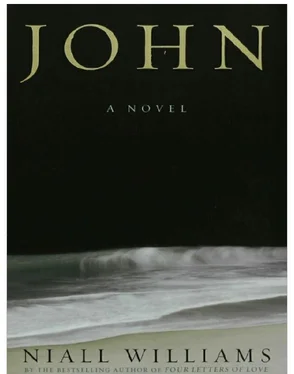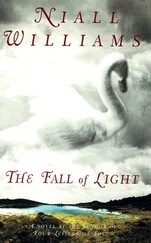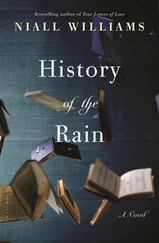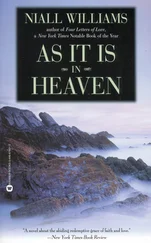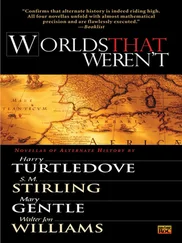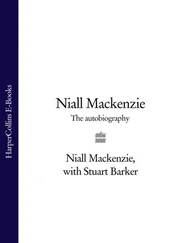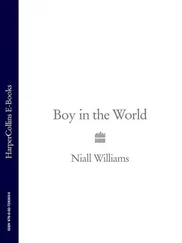He sees.
He sees and is humbled and uplifted both. He sees as if from a great height and is consoled.
The storm raging still, he lowers his arms. He speaks the names of the disciples gathered there and tells them not to fear.
He says, 'The Lord is with us.' Then he asks that one of them write what he will tell.
He sits. A light is lit.
In voice clear and strong, he begins to tell of the Baptist: 'There was a man sent from God whose name was John.'
He speaks on through dark. He does not stop. His manner is composed. Though outside the night is still broken, the disciples have no fear. Each has heard the Apostle teach pieces of the whole before, but here verse and chapter follow as though the words are already written. John does not grow weary. Into his voice comes sometimes anger at the world, sometimes sorrow, and sometimes nothing but the suffusion of love. Hour follows hour. He speaks long passages of the words of Jesus, and while he does, to those attending it seems a truth absolute, that these exact were the words spoken and by miracle in this man here preserved. In such a way is time overcome. There is no tarnish of age, no lack of clarity or pause for recall. The words are there, and are as an argument full of reason and logic. Phrases are balanced, built. Time and again certain words ring out. Love. Beloved. Friend. Truth. True. Glory. Command. World. Hour. Darkness. Light. And amidst these is all manner of the verb 'to remain'. Abide. Dwell on. Stay.
The composition continues. None can say for how long. Does the dawn come and the day pass and another night fall? Is it even on to the third day, as some will tell? Does the storm blow all the while? It does not matter. From this all else will follow. From this will be accounts numerous, versions of how and where and when that will continue even for thousands of years. There will follow scholars and sages, legions of the learned who in the coming history of the world will unearth possible traces of the gospel's genesis, what comes to be added after, what versions followed what and to what purpose in the unfolding of the early church. There will be one John, and then another. There will be argument and debate as to who wrote what and fragments of antique testimony offered in frail proofs. But none will matter. The words themselves will outlast all such. They will last to the very edge of eternity.
And this John knows as he says them. He knows the beginning and the end. He knows what work is his now, and that the world will not finish here, only his. He himself is already disappearing. He tells on. His spirit soars. He sees what is to come. He sees the numbers of the Christians grow. He sees the churches and thereafter the great cathedrals, the psalms, the songs, the composed Masses, the raptures and revelations of centuries of art divine yet to come. He sees the lives to follow of those about him, of Polycarp, of Lemuel, Meletios, and the others. He sees that on Patmos, Simon and old Ioseph are not dead but even now recover. As, too, in the fallen room in Ephesus where Kester tends to him, does the disciple Papias. The blisters retreat, the flesh is made new. In a day Papias will come to place the Apostle's hand upon his head. But already John will be near to discover that death is a doorway an instant long and beyond it is life everlasting. He sees this, and sees, too, how Papias will in time become bishop of Hierapolis, near Laodicea, and there himself write five books in his old age wherein he will tell of the apostle John, 'whose voice yet lives and remains.'
On and on it continues.
Vision is without end.
John tells his way to the resurrection. He tells it as now it will be told for all time. He tells it as testimony that God loves. And as he does, all feel the movement in their spirits from emptiness to fullness complete.
For here he is running to the tomb now and arriving first. Here he is, the sunlight in his hair. Here he is, little more than a youth running down the road, believing. The dust flies behind him. How swift he is. He sees the tomb opened and he cannot keep himself from joy. His hands he brings to his mouth. He would cry out. He would cry out with joy for ever now. The light fills in him as pure water that flows and flows. Love is resurrected.
He is risen. He is risen. He is risen.
My Lord, you are come.
I did not intend to write this novel. I intended only to find out the answer to a question that arrived in my mind one afternoon while I was working on another book. The question came to me out of the blue. It was: What was John doing the day before he wrote the gospel? I was not working on a religious theme. I had not been thinking of John or anything biblical, and had not at that point read all of the John gospel. But I had this question. What I wanted to know was something of the man. I supposed then that some basic research would answer the question and began a year of reading.
I was guided to the exhaustive work of Raymond E. Brown, one of the best-known Johannine scholars in the world. I read his translation of and commentary on John and the John epistles, as well as his study 'The Community of the Beloved Disciple', which attempts to reconstruct the history of one Christian community in the first century, and I would urge anyone seeking an in-depth historical perspective on the Johannine community to read his work. Through Brown I was led to other commentators, to Edwyn Hoskyns, Charles Kingsley Barnett, Robert Lightfoot, Willem Grossouw, Alan Robinson, Rudolf Schnackenburg, and many others. It quickly became apparent there was a vast Johannine literature, and within it were whole cycles of interpretation.
There are theories of all kinds surrounding this gospel. There was extreme scepticism; by some the gospel was dated late, even late into the second century. There was no connection between it and John, the son of Zebedee. For some there was no connection between the John gospel and the John epistles. Some commentators argue for three Johns; others that John is merely a name attached to the work of a community of Christians in the second century. It is only in more recent times that the author of the gospel is having his status as an orthodox Christian restored, with some commentators suggesting he may in fact have something to do with John, son of Zebedee. I have no doubt that there are already as many challengers of this interpretation as there are supporters.
A year in research and I was no closer to answering the question. There were few facts. It seemed a John had been exiled on Patmos. A John is believed to have died in Ephesus. But outside of these glimpses, I had begun to sense a man. As a novelist, I write not to tell what I think, but to find out what I feel. I began imagining a man. This was a very old man who had met Jesus of Nazareth when he himself was still a youth. What would it be like? What would it be like to have the most profound experience of your life when you were that young, to have witnessed what he had witnessed and then be left alone in the aftermath?
Slowly I began to understand that what drew me was the idea of faith, and that portion of it that is doubt. What if it was so? is the novelist's proposition, not It was so. So any questionable interpretations are my own, and should not be imputed to any of the sources listed above. This is a novel, not history nor biography. I hope it offers the rewards of a novel in depicting the inner life of a man of faith and doubt, and, most important, perhaps, what it might be to love for a lifetime.
Niall Williams was born in Dublin. He is a playwright and the author of the novels Four Letters of Love, As It Is in Heaven, The Fall of Light, Only Say the Word, and Boy in the World. He lives in County Clare with his wife, Christine, and their two children.
Читать дальше
